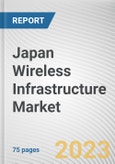The Japan wireless infrastructure market is expected to experience promising growth with increase in demand for 5G and IoT-based services along with advancements in wireless communication technologies. The factors responsible for market growth are technological advancements, increase in adoption of cloud-based technologies, and the potential to address the demand for broadband services.
The demand for wireless infrastructure is driven primarily by an increase in demand for high-speed internet services, technological advancements in wireless communication, and surge in market demand for 5G and IoT-based services. Moreover, government initiatives to introduce new technologies and support for the industry are likely to positively impact infrastructure growth. Increase in demand for wireless communication solutions, such as LTE, Wi-Fi, and LTE-advanced from MNOs & ISPs, is expected to accelerate market growth. Further, venture capital funding and favorable taxation policies are anticipated to drive market expansion.
On the other hand, high costs associated with setting up and maintaining telecom infrastructure are expected to hinder market growth. Moreover, tight security concerns, disputes over spectrum usage, and penalties imposed by governments and regulators on MNOs are expected to restrict market growth.
The Japan wireless infrastructure market is segmented into type, platform, and infrastructure. By type, the market is categorized into satellite, 3G, 4G, and 5G. On the basis of platform, it is segregated into government, defense, and commercial. By infrastructure, the market is divided into Small and Macro cells, Mobile Core, Radio Access Network, Distributed Area Network, and SATCOM.
Furthermore, the expansion of satellite-based wireless infrastructure has gained traction. In recent years, several notable trends have shaped the Japan wireless infrastructure market. The transition to 5G technology is at the forefront. With the promise of ultra-fast speeds and low latency, 5G is facilitating a wide range of applications, from autonomous vehicles to virtual reality. This transition fosters competition among telecom providers, leading to increased infrastructure investment.
Growth in the Japan Wireless Infrastructure Market is not limited to its technological landscape alone. It is a multifaceted journey, deeply intertwined with the socio-economic and political fabric of the nation. As it continues to expand, this market will have a ripple effect on employment, skill development, and research and development activities.
The concept of a 'Smart Nation' has gained momentum in Japan, which includes smart cities, IoT, and advanced communication systems, all of which necessitate a robust wireless infrastructure. The growth of the IoT market, driven by the need for connected devices and services, provides a favorable atmosphere for wireless infrastructure expansion.
Moreover, the surge in e-commerce, e-learning, and telehealth services due to the global pandemic has accentuated the demand for superior connectivity. The government has recognized the pivotal role of wireless infrastructure in national development. Regulatory reforms are underway to ease market entry and foster innovation. These reforms are expected to create new avenues for market players and startups, while also promoting competition.
Additional benefits you will get with this purchase are:
- Quarterly Update and* (only available with a corporate license, on listed price)
- 5 additional Company Profile of client Choice pre- or Post-purchase, as a free update.
- Free Upcoming Version on the Purchase of Five and Enterprise User License.
- 16 analyst hours of support* (post-purchase, if you find additional data requirements upon review of the report, you may receive support amounting to 16 analyst hours to solve questions, and post-sale queries)
- 15% Free Customization* (in case the scope or segment of the report does not match your requirements, 15% is equivalent to 3 working days of free work, applicable once)
- Free data Pack on the Five and Enterprise User License. (Excel version of the report)
- Free Updated report if the report is 6-12 months old or older.
- 24-hour priority response*
- Free Industry updates and white papers.
Possible Customization with this report (with additional cost and timeline, please talk to the sales executive to know more)
- Regulatory Guidelines
- Additional company profiles with specific to client's interest
- Additional country or region analysis- market size and forecast
- SWOT Analysis
Key Market Segments
By Type
- Satellite
- 2G and 3G
- 4G
- 5G
By Platform
- Government
- Defense
- Commercial
By Infrastructure
- Small and Macro cells
- Mobile Core
- Radio Access Network
- Distributed Area Network
- SATCOM
- Key Market Players
- NTT DoCoMo
- KDDI
- SoftBank
- Rakuten Mobile
- NEC Corporation
- Fujitsu
- Hitachi
- Mitsubishi Electric
- Sony Corporation
- NTT Communications
Table of Contents
Companies Mentioned
- NTT DoCoMo
- KDDI
- SoftBank
- Rakuten Mobile
- NEC Corporation
- Fujitsu
- Hitachi
- Mitsubishi Electric
- Sony Corporation
- NTT Communications
Methodology
The analyst offers exhaustive research and analysis based on a wide variety of factual inputs, which largely include interviews with industry participants, reliable statistics, and regional intelligence. The in-house industry experts play an instrumental role in designing analytic tools and models, tailored to the requirements of a particular industry segment. The primary research efforts include reaching out participants through mail, tele-conversations, referrals, professional networks, and face-to-face interactions.
They are also in professional corporate relations with various companies that allow them greater flexibility for reaching out to industry participants and commentators for interviews and discussions.
They also refer to a broad array of industry sources for their secondary research, which typically include; however, not limited to:
- Company SEC filings, annual reports, company websites, broker & financial reports, and investor presentations for competitive scenario and shape of the industry
- Scientific and technical writings for product information and related preemptions
- Regional government and statistical databases for macro analysis
- Authentic news articles and other related releases for market evaluation
- Internal and external proprietary databases, key market indicators, and relevant press releases for market estimates and forecast
Furthermore, the accuracy of the data will be analyzed and validated by conducting additional primaries with various industry experts and KOLs. They also provide robust post-sales support to clients.

LOADING...








